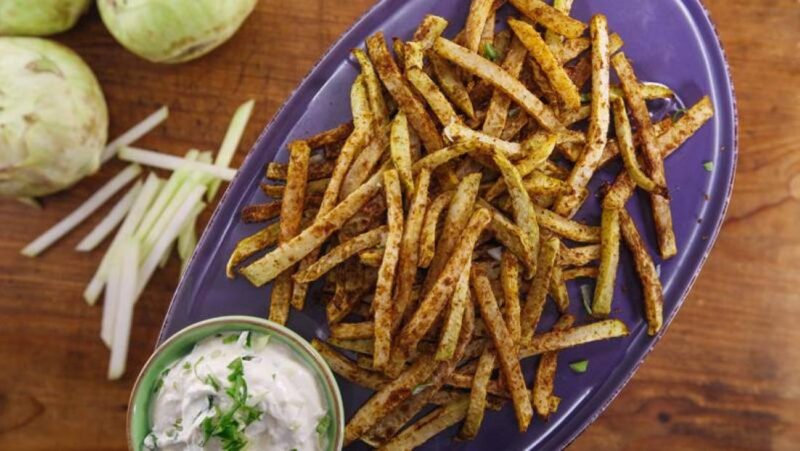Unveiling the Versatile Kohlrabi:
A Guide and Recipes
Have you ever come across a peculiar-looking vegetable in the produce section that resembles a mix between a turnip and a cabbage? If so, chances are you’ve encountered kohlrabi. Despite its alien appearance to some, this often-overlooked member of the Brassica family packs a flavorful punch and offers a myriad of culinary possibilities. Today, we’re diving into the world of kohlrabi – from its origins and nutritional benefits to some delicious recipes to incorporate this versatile vegetable into your meals.
What is Kohlrabi?
Kohlrabi, scientifically known as Brassica oleracea var. gongylodes, is a cool-season vegetable that belongs to the cabbage family. Its name is derived from the German words “kohl” meaning cabbage and “rübe” meaning turnip, which accurately describes its taste and appearance. Kohlrabi is characterized by its bulbous, globe-shaped stem, which grows just above the soil line. While the stem is the main edible portion, the leaves are also edible and can be cooked similarly to other leafy greens.
Nutritional Benefits
Despite its unusual appearance, kohlrabi is packed with essential nutrients, making it a valuable addition to any diet. Here are some of the key nutrients found in kohlrabi:
- Vitamin C: Kohlrabi is rich in vitamin C, which is essential for a healthy immune system and collagen production.
- Fiber: It’s a good source of dietary fiber, promoting digestive health and aiding in weight management.
- Potassium: Kohlrabi contains potassium, an electrolyte that helps regulate blood pressure and muscle function.
- Vitamin B6: This vegetable provides vitamin B6, which is important for brain health and metabolism.
- Antioxidants: It contains antioxidants such as carotenoids and flavonoids, which help protect cells from damage caused by free radicals.
Culinary Uses and Recipes
When it comes to preparing kohlrabi, the entire vegetable is edible, including the bulb and leaves. Here are some simple steps to prepare kohlrabi for cooking:
- Remove the leaves: Start by cutting off the leaves from the stem. You can save the leaves and use them in recipes, just like you would with other leafy greens.
- Peel the bulb: Use a vegetable peeler to remove the tough outer skin of the kohlrabi bulb. Once peeled, the inner flesh can be sliced or diced according to your recipe.
- Cook as desired: Kohlrabi can be enjoyed raw or cooked. It can be roasted, steamed, boiled, sautéed, or even pickled, depending on your preference.
Now that we’ve covered the basics, let’s explore how you can incorporate kohlrabi into your cooking. From raw salads to roasted side dishes, the possibilities are endless. Here are three delicious recipes to get you started:
Kohlrabi Slaw
Ingredients:
- 2 medium kohlrabi bulbs, peeled and julienned
- 1 carrot, peeled and julienned
- 2 tablespoons mayonnaise
- 1 tablespoon Dijon mustard
- 1 tablespoon apple cider vinegar
- 1 teaspoon honey or maple syrup
- Salt and pepper to taste
- Chopped fresh parsley (optional, for garnish)
Instructions:
- In a large bowl, whisk together mayonnaise, Dijon mustard, apple cider vinegar, honey or maple syrup, salt, and pepper.
- Add the julienned kohlrabi and carrot to the bowl and toss until well coated with the dressing.
- Cover and refrigerate for at least 30 minutes before serving.
- Garnish with chopped parsley before serving, if desired.
Roasted Kohlrabi Fries
Ingredients:
- 2 medium kohlrabi bulbs, peeled and cut into fries
- 2 tablespoons olive oil
- 1 teaspoon garlic powder
- 1 teaspoon paprika
- Salt and pepper to taste
Instructions:
- Preheat your oven to 425°F (220°C) and line a baking sheet with parchment paper.
- In a large bowl, toss the kohlrabi fries with olive oil, garlic powder, paprika, salt, and pepper until evenly coated.
- Spread the fries in a single layer on the prepared baking sheet.
- Roast in the preheated oven for 25-30 minutes, flipping halfway through, until the fries are golden brown and crispy.
- Serve hot with your favorite dipping sauce.
Kohlrabi and Potato Mash
Ingredients:
- 2 medium kohlrabi bulbs, peeled and diced
- 2 medium potatoes, peeled and diced
- 2 tablespoons butter or olive oil
- 1/4 cup milk or vegetable broth
- Salt and pepper to taste
- Chopped chives or parsley for garnish
Instructions:
- Place the diced kohlrabi and potatoes in a large pot and cover with water. Bring to a boil over medium-high heat and cook until tender, about 15-20 minutes.
- Drain the cooked kohlrabi and potatoes and return them to the pot.
- Add butter or olive oil, milk or vegetable broth, salt, and pepper to the pot.
- Use a potato masher or fork to mash the kohlrabi and potatoes until smooth and creamy.
- Adjust seasoning if necessary and garnish with chopped chives or parsley before serving.
Kohlrabi may not be the most familiar vegetable in the produce aisle, but its unique flavor and versatility make it worth exploring in the kitchen. Whether you enjoy it raw in salads, roasted as a side dish, or mashed as a comforting alternative to potatoes, kohlrabi is sure to add a delicious twist to your meals. So, the next time you spot this odd-looking vegetable, don’t hesitate to pick one up and get creative in the kitchen!


